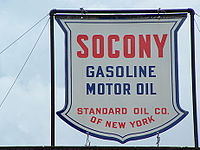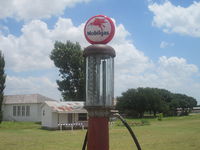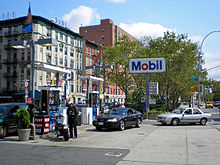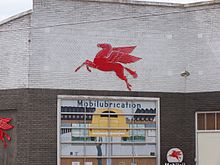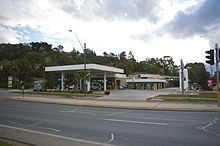- Mobil
-

Products: Gasoline
Convenience store
Some Locations:
Carwash
Automobile repair shopParent: ExxonMobil Sister Companies: Exxon
EssoCreation: 1911 Official Website: Official Website Mobil, previously known as the Socony-Vacuum Oil Company, was a major American oil company which merged with Exxon in 1999 to form ExxonMobil. Today Mobil continues as a major brand name within the combined company, as well as still being a gas station sometimes paired with their own store or On the Run. Its former headquarters in Fairfax County, Virginia, are currently used as ExxonMobil's downstream headquarters.[1][2]
Contents
History
Following the break-up of Standard Oil in 1911, the Standard Oil Company of New York, or Socony, was founded, along with 33 other successor companies. In 1920, the company registered the name "Mobiloil" as a trademark.
Henry Clay Folger was head of the company until 1923, when he was succeeded by Herbert L. Pratt. Beginning February 29, 1928 on NBC, Socony Oil reached radio listeners with a comedy program, Soconyland Sketches, scripted by William Ford Manley and featuring Arthur Allen and Parker Fennelly as rural New Englanders. Socony continued to sponsor the show when it moved to CBS in 1934. In 1935, it became the Socony Sketchbook, with Christopher Morley and the Johnny Green orchestra.
In 1931, Socony merged with Vacuum Oil to form Socony-Vacuum.[3]
In 1933, Socony-Vacuum and Jersey Standard (which had oil production and refineries in Indonesia) merged their interests in the Far East into a 50-50 joint venture. Standard-Vacuum Oil Co., or "Stanvac," operated in 50 countries, including East Africa, New Zealand and China, before it was dissolved in 1962.
In 1935, Socony Vacuum Oil opened the huge Mammoth Oil Port on Staten Island which had a capacity of handling a quarter of million gallons of petroleum products a year and could transship oil from ocean going tankers and river barges[4]
 The Mobil Economy Run generated publicity and promotions such as this 1962 advertisement by Champion spark plugs with a Rambler American.
The Mobil Economy Run generated publicity and promotions such as this 1962 advertisement by Champion spark plugs with a Rambler American.
In 1955, Socony-Vacuum was renamed Socony Mobil Oil Company. In 1963, it changed its trade name from "Mobilgas" to simply "Mobil," introducing a new logo (created by a prominent New York graphic design firm, Chermayeff & Geismar). To celebrate its 100th anniversary in 1966, "Socony" was dropped from the corporate name.
From 1936 to 1968, Mobil sponsored an economy run each year (except during World War II) in which domestic automobiles of various manufacturers in several price and size classes were driven by light-footed drivers on cross-country runs. The Economy Run originated with the Gilmore Oil Company of California in 1936 (which was purchased by Socony-Vacuum in 1940) and later became the Mobilgas Economy Run and still later, the Mobil Economy Run. The cars driven in the economy run were fueled with Mobil gasoline and Mobiloil and lubricants were also used. The vehicles in each class that achieved the highest fuel economy numbers were awarded the coveted title as the Mobilgas Economy Run winner.
During US involvement in WW II, April 29, 1942, Socony's unescorted tanker, named Mobiloil, was sunk by a German U-boat (U-108 captained by Klaus Schlotz), and all 52 people survived after 86 hours adrift in lifeboats.
Through the years, Mobil was among the largest sellers of gasoline and motor oils in the United States and even held the top spot during the 1940s and much of the 1950s. Various Mobil products during the Socony-Vacuum and Socony-Mobil years included Metro, Mobilgas and Mobilgas Special gasolines; Mobilfuel Diesel, Mobil-flame heating oil, Mobil Kerosine, Lubrite, Gargoyle, Mobiloil and Mobiloil Special motor oils; Mobilgrease, Mobillubrication, Mobil Upperlube, Mobil Freezone and Permazone antifreezes, Mobilfluid automatic transmission fluid, Mobil Premiere tires, Mobil Stop-Leak, Mobil Lustrecloth, among many others.
In 1954, Mobil introduced a new and improved Mobilgas Special in response to trends toward new automobiles powered by high-compression engines that demanded higher and higher octane gasolines. The newest formulas of Mobilgas Special was advertised as offering "A Tune-Up in Every Tankful" due to a combination of chemicals known as the "Mobil Power Compound" which was designed to increase power, check pre-ignition ping, correct spark plug misfiring, control stalling and combat gumming up of carburetors. Later Mobil campaigns advertised Mobilgas as the "New Car Gasoline" following extensive testing during the annual Mobilgas Economy Run.
In 1962, the gasoline product lines marketed as Mobilgas and Mobilgas Special were rebranded as Mobil Regular and Mobil Premium in a move to emphasize the shortened brand name "Mobil" in promotional efforts although Mobiloil continued as a single word term until the 1970s. After a few years of advertising Mobil gasolines as "Megatane"-rated and as "High Energy" gasolines, Mobil began, in 1966, to promote both its Regular and Premium fuels as "Detergent Gasolines," due to the inclusion of additives designed to clean carburetors and various internal engine parts. During the early 1970s, Mobil ran a TV commercial featuring a character known as "Mr. Dirt" to show the ruinous effects that dirt had on automotive engines for which a tank of Mobil Detergent Gasoline could provide a cure and preventive medicine against damage that could lead to costly repairs.
As automakers were switching en masse from carbureted to fuel injected engines during the early to mid-1980s, the detergent additives that existed in most available gasolines proved not to be enough to prevent injection clogging, leading to drivability problems, Mobil received accolades from General Motors and other automakers for increasing the detergency of its Super Unleaded gasoline in 1984 to prevent formation or deposit build-ups of the injectors but also remove existing deposits as well in normal driving. At the end of the 1980s Mobil sold its fuel stations in Norway, Sweden, and Denmark to Norsk Hydro, who converted them into Hydro stations.
William P. Tavoulareas was President of Mobil Corporation until succeeded by Allen E. Murray in 1984.
Mobil moved its headquarters from New York to Fairfax County, Virginia in 1987.[5]
In 1998, Mobil and Exxon agreed on a merger to create ExxonMobil, which was completed on November 30, 1999. Lou Noto was Chairman of Mobil at the time of the merger and Walter Arnheim was treasurer.[6]
When Exxon Corporation merged with Mobil Corporation in 1999, the newly merged company ended enrollment in Mobil Corporation's domestic partner benefits for same-sex partners of employees, and it rescinded formal prohibitions against discrimination based on sexual orientation by removing it from the company's Equal Employment Opportunity policy.[7]
Mobil brands
Mobil continues to operate as a major brandname of ExxonMobil. Many of its products feature the Mobil symbol of a winged red horse, Pegasus, which has been a company trademark since its affiliation with Magnolia Petroleum Company in the 1930s. Mobil encompasses three brands:
Mobil
The wider Mobil brand encompasses the Mobil service station and fuel (gasoline, diesel, heating oil, kerosene, aviation fuels and marine fuel) divisions. The Mobil brand also covers the wide range of lubricants (commercial & industrial, aviation and marine).[8]
Mobil 1
Mobil 1, the successor to the Mobiloil brand, is a brand name of ExxonMobil. It was introduced in 1974 as a single grade 5W20 viscosity synthetic motor oil. The brand now includes multi-grade motor oils, oil filters, synthetic grease, transmission fluids, and gear lubricants.[9] It is the GM warranty requirement for the Chevrolet Corvette [10] and is recommended for the fifth-generation Chevrolet Camaro.[11]
Mobil Delvac
Mobil Delvac is a range of heavy-duty lubricants; including engines oils, drivetrain lubricants and greases.[12]
Mobil Travel Guide
The Mobil Guide was an annual book of hotel and restaurant recommendations based on a system developed by Mobil in 1958. It rated businesses from one to five stars according to their assessed quality. In October 2009, ExxonMobil licensed the brand to Forbes magazine, which retitled the guide's various designations, e.g., Forbes Travel Guide, Forbes Five Stars, and so on. Forbes launched revised versions of various guides in late 2009.[13][14]
Lukoil transaction
In 2000, Lukoil purchased the remaining assets of Getty Oil, and began opening Lukoil stations in the US in 2003. Most of the US Lukoil locations are converted Getty stations, although some are also converted Mobil stations bought from ConocoPhillips when that company left the Northeast.
In Spring 2004, Lukoil purchased 779 Mobil gas stations throughout New Jersey and Pennsylvania, and in 2005 began converting them to the Lukoil brand. Most New Jersey Mobil locations were converted to Lukoil stations.
Mobil UK
Vacuum Oil Company started selling lubricating oils in Europe in the late 19th century. By the 1930s its Mobiloil had become one of the main brands. Mobil gradually expanded its operation into fuels retailing as well, and opened its first UK service stations in the early 1950s, after the wartime POOL monopoly was disbanded. Mobil grew to become the seventh largest brand of petrol in Britain supplying 1,990 outlets in 1965, and claimed in the mid-1960s to be the first company to operate 100 self-service stations. As well as its downstream interests, Mobil was active in the North Sea and operated an oil refinery in Coryton (opened in 1953), on the Thames estuary. In 1996, Mobil's fuels operations in Europe were placed into a joint venture 70% owned by BP and the Mobil brand disappeared from service stations. Mobil continued to sell lubricants through BP and independent service stations. Following Mobil's merger with Exxon, at the start of 2000 BP acquired all the petrol retailing assets as well as the Coryton refinery (but sold it to Petroplus in 2007). Mobil returned to being purely a lubricant brand in Europe, and became the premium quality oil on sale at Esso service stations.
Mobil Australia
The Vacuum Oil Company began operating in Australia in 1895, introducing its Plume brand of petrol in 1916. The Flying Red Horse logo was introduced in 1939, and in 1954 the Plume brand was replaced by Mobilgas.
Mobil constructed its Altona refinery in Melbourne in 1946, originally producing lubricating oils and bitumen, before producing motor vehicle fuels in 1956. A second refinery at Port Stanvac, south of Adelaide, came on stream in 1963, before being closed in 2003.[15] Mobil commenced removal of the refinery in July 2009, together with site remediation works.[16]
In 1990, Mobil acquired the service station network of Esso Australia. On 27 May 2009, Caltex Oil Australia Ltd. announced it would be acquiring 302 Mobil service stations in Sydney, Melbourne, Brisbane and Adelaide, subject to approval of the Australian Competition and Consumer Commission.[17] The ACCC subsequently announced its opposition to the takeover,citing the likelihood of increased fuel prices due to diminished competition.[18] United fuel Australia announced on 27 May 2010 that it had acquired Mobil's entire Australian network of 295 service stations. At the same time, it was announced that United had on sold 29 South Australian service stations to Peregrine Corporation. Peregrine's acquisition will see Mobil's sites in South Australia rebranded to On the Run convenience stores.[19]
References
- ^ "Mobil Corporation". Americancompanies.com. http://www.americancompanies.com/location.asp?ID=Washington%20DC. Retrieved 2010-07-25.
- ^ "Headquarters". .exxonmobil.com. http://www2.exxonmobil.com/SiteFlow/SuppInfo/Contacts/SF_CT_BusHeadquarters.asp. Retrieved 2010-07-25.
- ^ "Business & Finance: Socony-Vacuum Corp.," Time, 1931-08-10, retrieved on 2009-12-10.
- ^ Oil Port Can Serve City of Half a Million Popular Mechanics, October 1935
- ^ Dawson, Jennifer (January 15, 2010). "Exxon Mobil campus ‘clearly happening’". Houston Business Journal. http://houston.bizjournals.com/houston/stories/2010/01/18/story2.html?b=1263790800^2732161&page=2. Retrieved 24 July 2010.
- ^ Myerson, Allen R. (4 December 1998). "The Lion and the Moose - How 2 Executives Pulled off the Biggest Merger Ever". The New York Times. http://www.nytimes.com/1998/12/04/business/the-lion-and-the-moose-how-2-executives-pulled-off-the-biggest-merger-ever.html?pagewanted=all. Retrieved 24 July 2010.
- ^ "Human Rights Campaign - Equality at Exxon Mobil Corporation". http://www.equalityatexxon.org. Retrieved 2008-03-07.
- ^ "Lubricants". Mobil.com. http://www.mobil.com/USA-English/Lubes/Products_Services/Lubricants/Lubricants_Collection.asp. Retrieved 2010-07-25.
- ^ http://www.mobiloil.com/USA-English/MotorOil/Home/Homepage.aspx
- ^ http://www.mobiloil.com/USA-English/MotorOil/Factory_Fill/Mobil_1_Corvette.aspx
- ^ http://www.businesswire.com/news/home/20090803005202/en/Mobil-1-Selected-Factory--Service-Fill-Endorsed-Motor
- ^ "Lubricants". Mobildelvac.com. http://www.mobildelvac.com/usa-english/lubes/products_services/lubricants/Delvac_products.asp. Retrieved 2010-07-25.
- ^ "Mobil Travel Guide to become Forbes Travel Guide". Associated Press. 2009-08-04. http://www.usatoday.com/travel/news/2009-08-05-mobil-forbes-guide_N.htm.
- ^ Carly Zinderman (2009-12-03). "Hotel Rankings: Forbes Merges with Mobil". International Business Times. http://www.ibtimes.com/contents/20091203/hotel-rankings-forbes-merges-with-mobil.htm.
- ^ "Jamieson oil industry history". Home.austarnet.com.au. http://home.austarnet.com.au/jamieson/mobilgas.html. Retrieved 2010-07-25.
- ^ "Mobil news". Exxonmobil.com.au. 2009-06-25. http://www.exxonmobil.com.au/Australia-English/PA/news_releases_20090625.aspx. Retrieved 2010-07-25.
- ^ Durie, John (2009-05-27). "Caltex pumps for control". The Australian. http://www.theaustralian.news.com.au/story/0,25197,25545618-5013408,00.html. Retrieved 2010-07-25.
- ^ Freed, Jamie, "Watchdog blocks Caltex bid", Sydney Morning Herald, http://www.smh.com.au/business/watchdog-blocks-caltex-bid-for-mobil-servos-20091202-k5cz.html, retrieved 2009-03-12
- ^ "Exxon Mobil sells service station network". The Australian. 27 May 2010. http://www.theaustralian.com.au/business/industry-sectors/exxon-mobil-sells-petrol-station-network-to-7-eleven/story-e6frg9h6-1225872179012. Retrieved 27 May 2010.
External links
Categories:- ExxonMobil subsidiaries
- Chemical companies of the United States
- Oil companies of the United States
- 1920s American radio programs
- Automotive companies of the United States
- Automotive fuel brands
- Companies established in 1911
- Multinational companies
- Oil and gas companies of Australia
- Oil companies of Germany
- Gas stations in Canada
- Companies based in Virginia
- ExxonMobil brands
Wikimedia Foundation. 2010.

